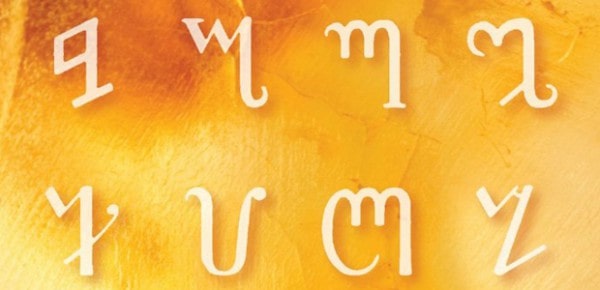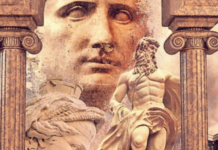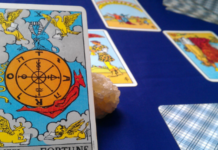
 The Theban Oracle, by Greg Jenkins, PhD
The Theban Oracle, by Greg Jenkins, PhD
Weiser Books, 978-1-57863-549-8, 237 pp, (incl. appendix and bibliography), 2014
There are effectively three books within The Theban Oracle: an introduction to what the author calls “Medieval Metaphysics,” including the few references to the Theban alphabet; a method for divination using the alphabet and correspondences created by the author, which requires the reader to make a casting set using the instructions included; and examples of spell-casting with the support of the Theban letters.
The divination material occupies about two thirds of the book, so I will address it first. The 24 letter-stones (for which I now coin the term grammatoliths) of the Theban alphabet, plus a blank, are associated with various figures from the history of magick and spirituality. The divinatory meanings of each grammatolith are drawn from major aspects of the corresponding personality, whether from the importance of their known work or their place in history. To name a few, we have Trithemius, Agrippa, Dee, Paracelsus, Hypatia, and Imhotep, along with others in the Western Esoteric Tradition, and then Lao Tzu as the sole Far Eastern figure. One might be able to suggest a pre-Socratic philosopher to use instead (Empedocles leaps to mind), but I suppose they are not well-known enough today, and it’s important that the diviner be able to relate to the given figures.
Three tarot-like spreads are suggested, along with hints for the more obvious use of the stones in sortilège, that is, casting whichever stones feel like they have something to say and then reading them by free association.
The divination instructions give upright and reversed meanings, depending on the orientation of the grammatolith as laid. They make sense, on perusal, but the diviner might want to consider if the oracle would work better without the reversals. As a practical matter, if reversals were to be considered, making the stones regular and symmetrical would simplify matters. One might consider simply printing up a set of cards, although Jenkins’ rhapsody regarding the spiritual qualities of wood, stone, shell, and bone in the chapter on making a casting set implies that he intentionally avoided cards. He relates his method to various other oracles in a variety of cultures, but misses Greek grammatomancy, the one this oracle most closely resembles.
I had no doubt that the divination method would work, because, to quote my favourite professional diviner, Lilith Presson: “If you have a talent for divination, you can read from a handful of Cheerios. If you don’t, it doesn’t matter what you use.” It seemed only fair to make some “stones”1 and try a few test readings. I did a couple of one-card draws, a three-card reading, and a sortilège cast, while sitting in the parlour of my favourite occult coffee shop.
The oracle warned a friend of mine about false and manipulative people, which was correct; she already knows she attracts those. It warned me that I might lose my love for astrology if I tried to do it professionally. It also told me that the nice day I was having wasn’t going to last. That was partly true, but it got better again. Lots better.
The overall feel is similar to reading with the tarot major arcana. There is an occasional need to adjust the drama level downwards as you interpret. I actually found this oracle quite fun to use and reasonably accurate.
At any rate, it is clear from the tone of this part of the book that Jenkins has worked with his grammatoliths extensively, and found them a valuable companion on his journeys. So might someone else.
The material on spell-casting that incorporates the Theban letters is straightforward. The workings are consistent with the natural magic of the grimoire and witchcraft traditions, and the letters as reimagined by Jenkins fit right in. There are some places where things could be tightened up. For example, the first spell given is to draw love, and it references doing something starting at 5:00 one Sunday afternoon, then undoing it at 6:00 the next Sunday. This is clearly an interpretation of “start this at the beginning of a Venus hour, then finish it at the end of one the next week.”
The author comes within a whisker of explicitly saying that what he is doing by associating powerful people with the letters, and creating and consecrating grammatoliths with these associations in mind is precisely creating talismans based on the spirits of the Mighty Dead. Those familiar with the talismanic art can make the necessary adjustments.
It is in the background material that the book runs into trouble. In a table of associations between the Latin alphabet, Theban, and Hebrew,2 the Latin column is actually the 26-letter English alphabet, but this is compensated for by showing the same Theban glyph for I and J and for U and V, and the modern double-V for W.3 Very well, but the Hebrew column is an inexplicable scramble in which no more than four letters actually occur in the right places. When the associations are repeated in the appendix, the same correspondences are shown, plus the names of the Hebrew letters are spelled with many strange variations.4 There is also no acknowledgement of the “standard” correspondences of the Hebrew letters, or really much justification for including them. This could have been done in the section about the Tree of Life, but that material is only there as background to a Tree of Life spread, and it is further weakened by having the Sephiroth numbered upside down.
When we first meet the Theban alphabet in the surviving manuscript tradition, it is mentioned by Agrippa (who was in turn quoting Trithemius’s Polygraphia) in chapter 24 of Book II of De Occulta Philosophia. While Trithemius’s work was encyclopedic, Agrippa emphasizes it, making it one of his few examples of hieratic writing. Both say that it was passed along by Peter de Abano, who got it from Honorius of Thebes, the author of Liber Juratus, and imply that it was once widely used for concealment of magical writings.
Liber Juratus comes with a stirring origin myth wherein all of the Egyptian Magi of the day entrust Honorius to write a master grimoire of all their secrets, requiring that it be protected from profanation by dire oaths (hence its sobriquet of “The Sworn Book.”)
There may be mysteries to be plumbed in the nature of the Theban script; Jenkins has made a good attempt. However, we don’t have any mention of the script in any surviving work of de Abano or in any manuscript of Honorius. As magicians, we can choose to believe as much or as little of the known mythology as suits our purposes; as scholars, we might be better advised to treat it as the usual sort of mythology that accompanies such things.
- I printed out the alphabet on card stock and cut the letters out. [↩]
- p. 22 [↩]
- W is not included in the divination section. [↩]
- Aieph, Hai, Waw, Zain, Lames, etc. – if this is done deliberately, we are not told why. [↩]








